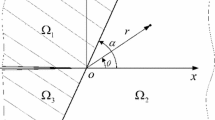Abstract
The finite element method with quarter-point crack-tip elements is used and a simple formula for obtaining the coefficients of the second-order terms in the series expansion for near crack tip stresses in orthotropic materials under biaxial loading is presented. This formula is obtained by comparing the variation of the displacements along the crack tip element with the elastic field solution for the crack tip. Numerical examples are given for the validity of the present formulation. The results obtained are compared with the theoretical ones and a good agreement between the two solutions is obtained.
Similar content being viewed by others
References
Boone TJ, Wawrzynek WA, Ingraffea AR: Finite element modelling of fracture propagation in orthotropic materials. Engng Fract Mech 26(2), 185–201 (1987)
Bowie OL, Freese CE: Central crack in plane orthotropic rectangular sheet. Int J Fract Mech 8(1), 49–58 (1972)
Carloni C, Nobile L (2002). Crack initiation behavior of orthotropic solids as predicted by the strain energy density theory. Theor Appl Fract Mech 38, 109-19.
Carloni C, Piva A, Viola E (2003). An alternative complex variable formulation for an inclined crack in an orthotropic medium. Engng Fract Mech 70, 2033-58.
FRANC2D (2007). Cornell Fracture Group. Available from: www.cfg.cornell.edu.
Garcia F, Saez A, Dominguez J (2004). Traction boundary elements for cracks in anisotropic solids. Boundary Analysis with Boundary Elements 28: 667-76.
Lim WK, Choi SY, Sankar BV (2001). Biaxial load effects on crack extension in anisotropic solids. Engng Fract Mech 68, 403-16.
Lim WK, Sankar BV (2002). Non-singular term effect for the inclined crack extension in anisotropic solids under uniaxial loading. J Compos Mater 36(17), 2031-44.
Nobile L, Carloni C (2005). Fracture analysis for orthotropic cracked plates. Composite Structures 68, 285-93.
Nobile L, Piva A, Viola E (2004). On the inclined crack problem in an orthotropic medium under biaxial loading. Engng Fract Mech 71, 529-46.
Saouma VE, Sijiotis ES (1986). Stress intensity factors in anisotropic bodies using singular isoparametric elements. Engng Fract Mech 25, 115-21.
Savin GN: Stress concentration around holes. Gordon and Breach Science Publisher, New York (1968)
Sih, GC, Liebowitz H (1968). Mathematical theories of brittle fracture in fracture mechanics, In:Liebowitz H ed. Fracture mechanics, vol.II. New York: Academic Press; 108-30.
Viola E, Boldrini C, Tornabene F (2008). Non-singular term effect on the fracture quantities of a crack in a piezoelectric medium. Engng Fract Mech 75, 4542-67.
Yang S, Yuan FG: Determination and representation of the stress coefficient terms by path-independent integrals in anisotropic cracked solids. Int J Fract 101(4), 291–319 (2000)
Yang S, Yuan FG (2000b). Kinked crack in anisotropic bodies. Int J Solids Struct 37, 6635-82.
Author information
Authors and Affiliations
Corresponding author
Rights and permissions
About this article
Cite this article
Lim, WK. Determination of Second-Order term Coefficients for the Inclined Crack in Orthotropic Plate using Singular Finite Elements. Int J Fract 168, 125–132 (2011). https://doi.org/10.1007/s10704-010-9569-3
Published:
Issue Date:
DOI: https://doi.org/10.1007/s10704-010-9569-3




